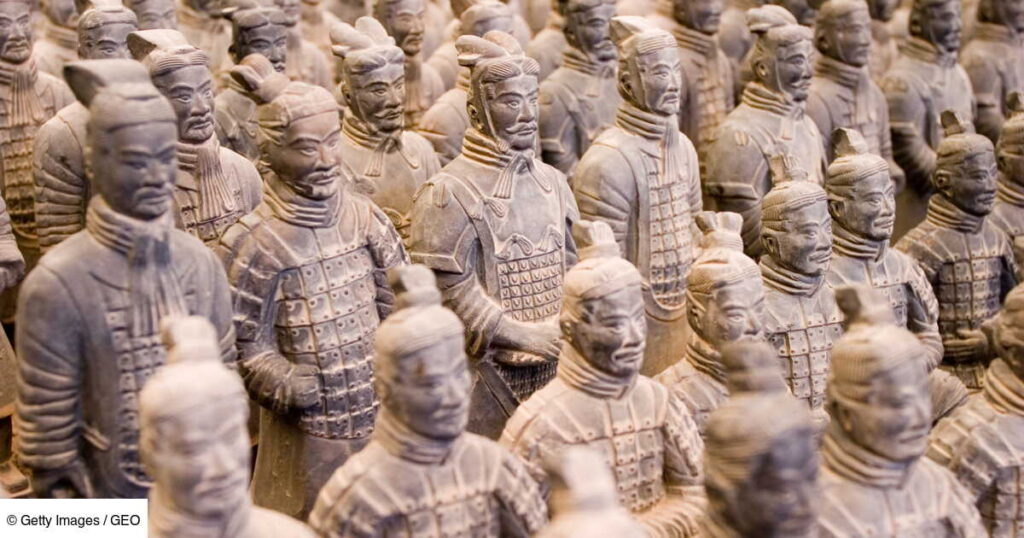The saga of Qin Shi Huang, China’s inaugural emperor, is nothing short of legendary. Renowned for his unification of China and the construction of what would eventually become the Great Wall, his reign has indelibly marked the country’s historical landscape. Yet, despite his monumental contributions, one component of his legacy remains shrouded in secrecy—his tomb. Nestled deep beneath the earth near Xi’an, central China, this burial site has sparked intrigue and speculation for centuries. Recent archaeological findings and historical documents, however, have led experts to reconsider the prospect of its excavation.
The Enigmatic Tomb of Qin Shi Huang
The tomb of Qin Shi Huang ranks among the globe’s most significant archaeological sites, not solely due to its immense scale and grandeur but also because of the astonishing terra cotta army that guards it. Unearthed in 1974, this army comprises thousands of life-sized warriors, commissioned to accompany the emperor into the afterlife. Yet, the allure of the tomb extends beyond these figures; it’s what remains undiscovered inside that raises apprehensions.
Constructed over an extensive span of 38 years by hundreds of thousands of workers, the emperor’s tomb was intended to reflect his monumental power and ambition. While segments of the tomb complex have undergone examination, the main burial chamber—where the emperor’s remains are believed to reside—has remained undisturbed for over 2,200 years. There are compelling reasons for this preservation.
The Hidden Dangers of Qin Shi Huang’s Tomb
Ancient historical texts, particularly those penned by historian Sima Qian, contain ominous warnings about the traps safeguarding the tomb. Reports suggest it was rigged with deadly mechanisms including crossbows and arrows primed to strike intruders. Adding to the chilling atmosphere, the tomb is thought to have been filled with mercury, mimicking the vast rivers and seas of China, such as the Yangtze and the Yellow River.
Initially dismissed as mere folklore, recent studies—including a notable 2020 publication in Nature—revealed elevated mercury levels surrounding the tomb, spurring fresh concerns that this hazardous element may have been integral to the burial process. Estimates suggest the tomb could contain upwards of 100 tons of mercury, a concentration that likely persists within the tomb’s confines. Such findings raise alarming possibilities about the exposure to toxic mercury vapors should any excavation occur.
The Risks of Deterioration
In addition to the physical hazards, entering Qin Shi Huang’s tomb poses severe risks to its preservation. Archaeologists express deep concern over the potential detrimental effects of time and prior excavation damage. For example, the vibrant colors originally adorning the terra cotta soldiers have faded significantly due to exposure to air and light from earlier digs.
Sima Qian’s ancient writings also indicate that the tomb was said to house vast treasures—rare jewels, valuable artifacts, and ceramics meant to accompany the emperor in the afterlife. The fear is real: opening the tomb could further endanger these irreplaceable historical items, not to mention the potential structural damage to the tomb itself.
The Emperor’s Obsession with Immortality
Qin Shi Huang was more than a conqueror and builder; he was fixated on the concept of immortality. His relentless pursuit of eternal life led him to experiment with various alchemical concoctions, many of which were found to be toxic, such as mercury itself. It’s said that he ingested a mixture of wine, honey, and mercury in hopes of extending his life—a perilous habit that may have contributed to his untimely demise at the age of 49.
This fascination with immortality may explain the unusual and foreboding layout of his tomb, designed not only as a final resting place but also as a means to preserve his legacy. Although his reign was swiftly followed by the disintegration of his empire, his legendary status as China’s first emperor endures.
Preserving History
While the tomb of Qin Shi Huang remains an alluring enigma, the risks associated with its exploration are significant. Concerns over mercury contamination and the potential for irreparable damage necessitate a cautious approach for archaeologists. In a world increasingly captivated by ancient mysteries, the balance between exploration and conservation grows ever more complex. The decision to unveil the tomb must be made with the utmost prudence, weighing the thirst for knowledge against the imperative of preservation.
The narrative of Qin Shi Huang and his tomb serves as a profound reminder that the past can harbor both physical and ethical dangers, and some mysteries may be better left undiscovered for the time being. Whether his tomb will ever see the light of day again, the legend of China’s first emperor will undoubtedly continue to shape the narrative of its ancient history.







